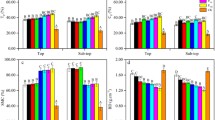Abstract
Soil biologists acknowledge that soil is structurally heterogeneous and that the soil environment varies with time. For practical reasons, most experimental work on soilborne plant pathogens implicitly assumes that soil is homogeneous, or is done under constant conditions. Recently soil scientists have developed powerful new tools for describing soil structural heterogeneity. In this paper we discuss the potential for one of these, fractal geometry, to be used in situations such as determining the relationship between soil texture and disease prevalence, or between tillage and disease severity. The more widespread use of soil wetness duration as a measure of soil water status in field and pot experiments under fluctuating moisture conditions is advocated.
Similar content being viewed by others
References
Akasaka, Y., Mii, M. and Daimon, H. (1998) — Morphological alterations and root nodule formation in Agrobacterium rhizogenes-mediated transgenic hairy roots of peanut (Arachis hypogaea L.). Annals of Botany 81: 355–362.
Anderson, A.N., McBratney, A.B. and Crawford, J.W. (1998) — Applications of fractals to soil studies. Advances in Agronomy 63: 1–76.
Crawford, J.W., Ritz, K and Young, I.M. (1993) — Quantification of fungal morphology, gaseous transport and microbial dynamics in soil: an integrated framework utilising fractal geometry. Geoderma 56: 157–172.
Donnelly, D.P. and Boddy, L. (1997) — Development of mycelial systems of Stropharia caerulea and Phanerochaete velutina on soil: effect of temperature and water potential. Mycological Research 101: 705–713.
Eshel A. (1998) — On the fractal dimensions of a root system. Plant Cell and Environment 21: 247–251.
Felton, W.L., Marcellos, H., Alston, C., Martin, R.J., Backhouse, D., Burgess, L.W. and Herridge, D.F. (1998) — Chickpea in wheat-based cropping systems of northern New South Wales 11. Influence on biomass, grain yield, and crown rot in the following wheat crop. Australian Journal of Agricultural Research 49: 401–407.
Fernandes, J.M.C., Sutton, J.C. and James, T.D.W. (1991) — A sensor for monitoring moisture of wheat residues: application in ascospore maturation of Pyrenophora tritici-repentis. Plant Disease 75: 1101–1105.
Hare, M.C. and Parry, D.W. (1996) — Observations on the maintenance and measurement of soil water in simple pot experiments and its effects on seed-borne Fusarium culmorum seedling blight of winter wheat. Annals of Applied Biology 129: 227–235.
Kaye, B.H. (1989) — A Random Walk Through Fractal Dimensions. New York: VCH Publishers.
Kravchenko, A. and Zhang, R. (1998) — Estimating the soil water retention from particle-size distributions: a fractal approach. Soil Science 163: 171–179.
Liddell, C.M. and Burgess, L.W. (1988) — Wax partitioned soil columns to study the influence of soil moisture potential on the infection of wheat by Fusarium grarninearum Group 1. Phytopathologv 78: 185–189.
Lipiec, J., Hatano, R. and Slowinska-Jurkiewicz, A. (1998) — The fractal dimension of pore distribution in variously compacted soil. Soil and Tillage Research 47: 61–66.
McKnight, T. and Hart, J. (1966) — Some field observations on crown rot disease of wheat caused by Fusarium graminearum. Queensland Journal of Agricultural and Animal Sciences 23: 373–378.
Nicholas, W.L. (1984) — The Biology of Free-living Nematodes, 2nd edn. Oxford: Clarendon Press.
Perfect, E. and Blevins, R.L. (1997) — Fractal characterization of soil aggregation and fragmentation as influenced by tillage treatment. Soil Science Society of America Journal 61: 896–900.
Perfect, E. and Kay, B.D. (1995) — Applications of fractals in soil and tillage research: a review. Soil and Tillage Research 36: 1–20.
Pettitt, T.R., Parry, D.W. and Polley, R.W. (1996) — Effect of temperature on the incidence of nodal foot rot symptoms in winter wheat crops in England and Wales caused by Fusarium culmorum and Microdochiurn nivale. Agricultural and Forest Meteorology 79: 233–242.
Roget, D.K., Neate, S.M. and Rovira, A.D. (1996) — Effect of sowing point design and tillage practice on the incidence of Rhizoctonia root rot, take-all and cereal cyst nematode in wheat and barley. Australian Journal of Experimental Agriculture 36: 683–693.
Scherm, H. and Yang, X.B. (1996) — Development of sudden death syndrome of soybean in relation to soil temperature and soil water matric potential. Phytopathology 86: 642–649.
Summerell, B.A. and Burgess, L.W. (1988) — Factors influencing production of pseudothecia by Pyrenophora tritici-repentis. Transactions of the British Mycological Society 90: 557–562.
Swan, L. J. (1998) — Field studies on factors influencing the progressive infection of wheat by Fusarium graminearum Group 1. MScAgr Thesis, University of Sydney.
Trudgill, D.L. (1996) — A thermal time basis for understanding pest epidemiology and ecology. In Principles and Practice of Managing Soilborne Plant Pathogens (Ed R. Hall), pp. 124–133. St Paul: APS Press.
Tu, J.C. (1994) — Effects of soil compaction, temperature, and moisture on the development of the Fusarium root rot complex of pea in southwestern Ontario. Phytoprotection 75:125–131.
Young, I.M. and Ritz, K. (1998) — Can there be a contemporary ecological dimension to soil biology without a habitat? Soil Biology and Biochemistry 30:1229–1332.
Zhang, W. and Pfender, W.R (1992) — Effect of residue management on wetness duration and ascocarp production by Pyrenophora tritici-repentis in wheat residue. Phytopathology 82: 1434–1439.
Author information
Authors and Affiliations
Corresponding author
Rights and permissions
About this article
Cite this article
Backhous, D., Nehl, D.B. Fractal geometry and soil wetness duration as tools for quantifying spatial and temporal heterogeneity of soil in plant pathology. Australasian Plant Pathology 28, 27–33 (1999). https://doi.org/10.1071/AP99004
Issue Date:
DOI: https://doi.org/10.1071/AP99004




